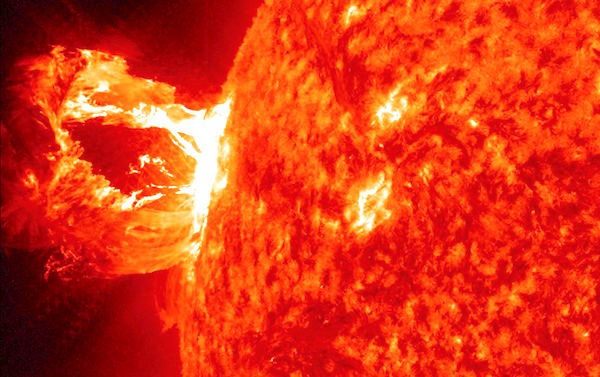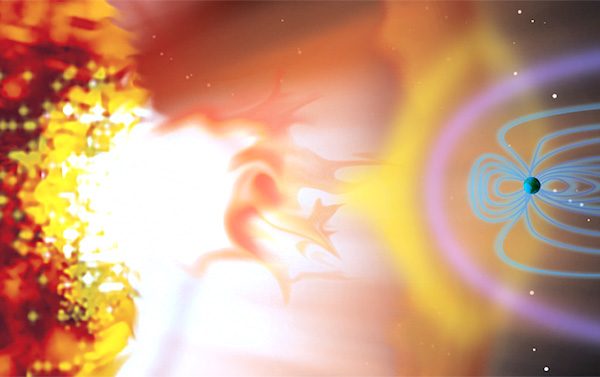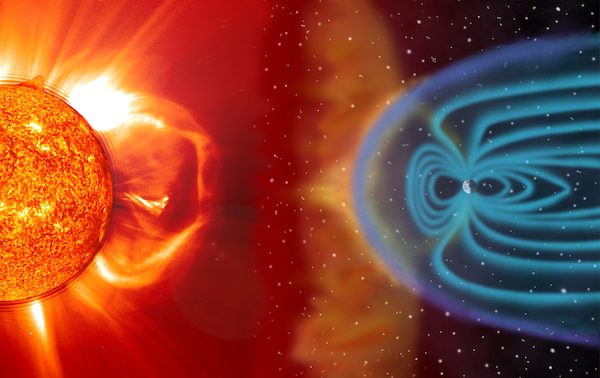Solar superflares warmed the Earth enough to set the condition necessary for life, according to research published in Nature Geoscience. The study builds on an earlier discovery about young, sun-like stars sending superflares made with NASA’s Kepler Space Telescope.
Baby suns, it turns out, are extremely eruptive, releasing mind-boggling amounts of energy during “solar superflares” that make our wildest space weather look like drizzle, Space reports. If a massive solar storm struck the Earth today, it could wipe out our technology and hurl us back to the dark ages.
Lucky for us, solar superflares that warmed the Earth enough to set the condition necessary for life are rare. But four billion years ago, extreme space weather was probably the norm. And rather than bringing the apocalypse, it might have kickstarted life.
Now, NASA’s Vladimir Airapetian has shown that if our sun was equally active 4 billion years ago, it could have made the Earth more habitable. According to Airapetian’s models, as solar superflares pounded our atmosphere, they initiated chemical reactions that yielded climate-warming greenhouse gases and other essential ingredients for life.
“The Earth should have been in a deep freeze four billion years ago,” Airapetian said, referring to the “faint young sun paradox” first raised by Carl Sagan and George Mullen in 1972. The paradox came about when Sagan and Mullen realized that Earth had signs of liquid water as early as 4 billion years ago, while the sun was only 70 percent as bright as it is today. “The only way [to explain this] is to somehow incorporate a greenhouse effect,” Airapsetian said, pointing out that it is possible that solar superflares warmed the Earth.
Another early Earth puzzle is how the first biological molecules-DNA, RNA and proteins-scavenged enough nitrogen in order to form. Similar to today, the ancient Earth’s atmosphere was composed primarily of inert nitrogen gas (N2). While specialized bacteria called “nitrogen fixers” eventually figured out how to break N2 and turn it into ammonia (NH4), early biology lacked this ability, Discovery Communications reported.
The new study offers an elegant solution to both of these problems in the form of space weather. The research began several years back, when Airapetian was studying the magnetic activity of stars in NASA’s Kepler database. He discovered that G-type stars (stars like our sun) are like dynamite in their youth, frequently releasing pulses of energy equivalent to over 100 trillion atomic bombs. The most powerful solar storm ever experienced by humans, the 1859 Carrington event that caused worldwide power outages, pales in comparison.
“It is a crazy amount of energy. I can hardly comprehend it myself,” Ramses Ramirez—an astrobiologist at Cornell University who was not involved with the study but collaborates with Airapsetian said.
It soon occurred to Airapetian that he could use this discovery to peer back into the early history of our solar system. He calculated that 4 billion years ago, our sun could have been releasing dozens of superflares every few hours, with one or more grazing the Earth’s magnetic field every single day. “Basically, the Earth was under constant attack from super Carrington-sized events,” he said.
Using numerical models, Airapetian then showed that solar superflares would be strong enough to dramatically compress Earth’s magnetosphere, the magnetic shield that encircles our planet. Not only that, charged solar particles would bust a hole clean through the magnetosphere near our planet’s poles, entering the atmosphere and colliding with nitrogen, carbon dioxide and methane. “So now you have these particles interacting with molecules in the atmosphere and creating new molecules-like a chain reaction,” Airapsetian said.
Quadrangle said that’s why scientists believe that solar superflares warmed the Earth for life. These solar-atmospheric interactions produce nitrous oxide, a greenhouse gas with 300 times the global warming potential of CO2. Airapetian’s models suggest that enough nitrous oxide could have been produced to dramatically warm the planet. Another product of the endless solar storm, hydrogen cyanide (HCN), could have fertilized the surface with the nitrogen needed to form the early building blocks of life.













